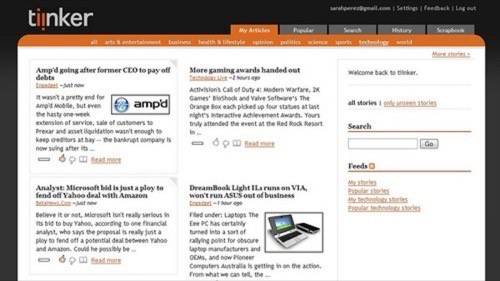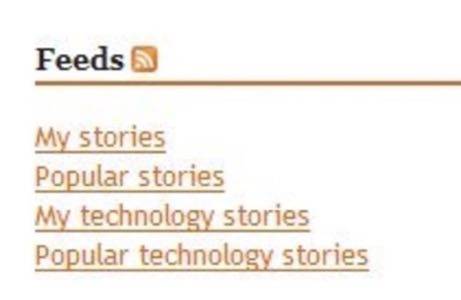
Whereas the social news service from Digg relies on members to select and rank
content, a new startup from Sydney, Australia,
, does just the opposite: it treats
each member as an individual and learns what he or she likes.
The service, an
intelligent news aggregator, uses A.I.-like technology to determine your
interests and then adapts to show you the news stories you will find most
interesting. And since
web
3.0 may be all about personalization
, tiinker just might be the next big
thing.
One of the first things you’ll notice about tiinker is that you don’t have to
create an account to try it out. Tiinker will remember you for a while using a
browser cookie. You can click “try it now” from the home page to start rating
stories up or down without ever having to log in. If you like the service,
though, you’ll want to create an account to save those rankings.
The interface itself is slick, fast, and easy to use. By default, tiinker
aggregates content from thousands of news sources and blogs and sorts them into
the categories of arts & entertainment, business, health & lifestyle,
opinion, politics, science, sports, technology, and world. The stories are
selected for you completely automatically, no humans involved. This is the key
difference between tiinker and the other social news aggregators out there. With
tiinker, story selection is all about you and what you are into – you can’t even
cross-reference your selections with others like you or your friends. This is a
personalized news service, not a social network.

The news stories are chosen for you based on a complex mix of analysis of
what they’re about, how much you’re interested in similar topics, how long ago
they were published, where in the world they come from, and other factors.
Tiinker will also sometimes present what they call “lucky dip” stories which
are chosen to broaden the range of news you see, by exploring new topics outside
of your common interests.
Ranking stories is as easy as clicking on the “thumbs up” or “thumbs down”
and will help train tiinker to learn your preferences. You’ll see stories
becoming relevant to you after you’ve rated only a few articles, but it may take
a few more visits for tiinker to really know what you like. The algorithm is
continually learning as you use it and will get better at choosing interesting
stories over time.
When you “thumbs down” an item, the service eliminates those kinds of stories
from your profile right away. You also won’t see stories appear from categories
you don’t browse. However, if you make a mistake and accidentally rank a story
incorrectly, a useful feature allows you to click the thumbs icon again to undo
your selection.
Another unique option is the ability for service to email you stories if
desired. Upon signup, you can select to have tiinker email you stories daily,
weekly, or never. You can also change this option in your settings at any time.
There’s an RSS feed available for your stories, and if you are
interested in what the masses are reading, you can check out the “Popular” page,
which has a feed as well. If you want to narrow it down further, each category
page has a personalized feed and a popular feed, too.

If you start running out of things to read, you can click the “only unseen
stories” link to see all the stories that have never been displayed for you. You
might surprise yourself and find something of interest here.
To mark stories and save them for later by, you click the book icon
underneath the item, which will save it to your “Scrapbook,” a section of the
site that holds saved stories. Of course, there’s a feed for this as well.
Tiinker looks like a great service to help you sort through the massive
amount of news published daily and gives you a more personal alternative
to sites like Digg. However, advanced RSS users will probably still want to use
their feed readers in order to maintain control over their news sources, perhaps
only using tiinker feeds to supplement their current RSS list. Still,
the service is a big step forward in the capabilities of machine learning and
for that alone, it’s worth a look.







